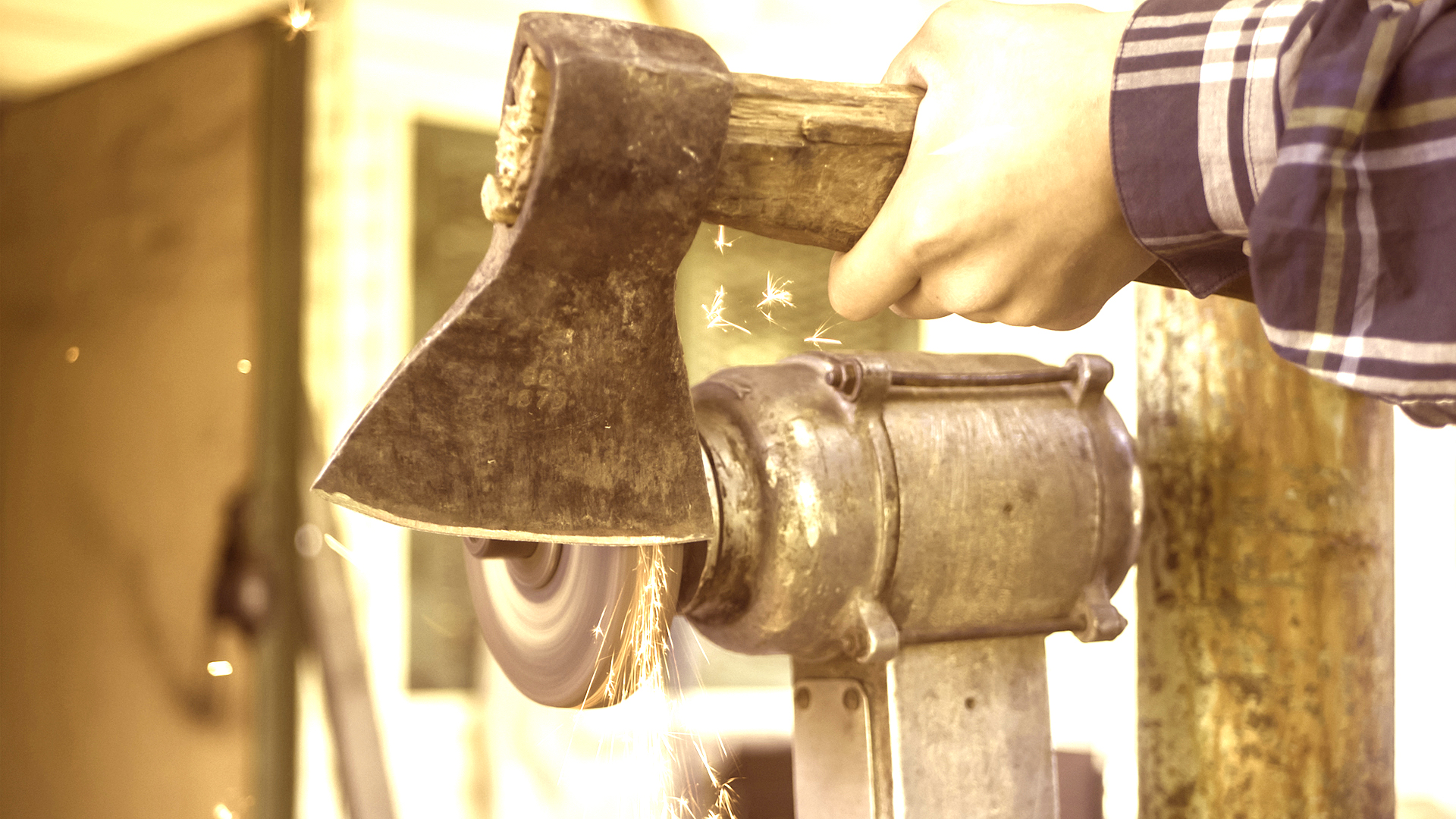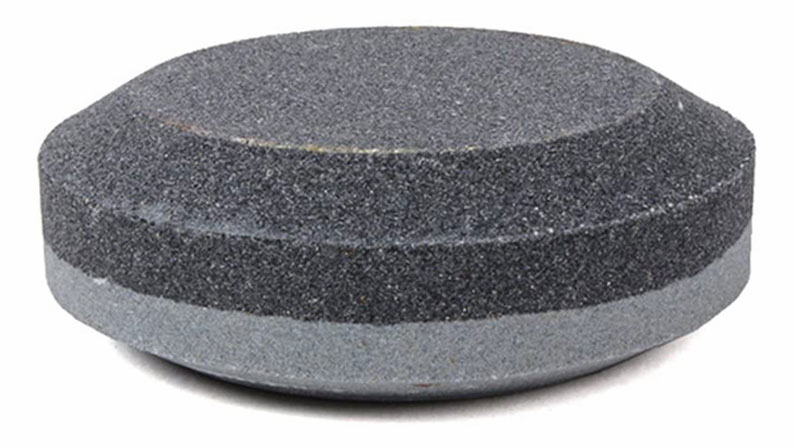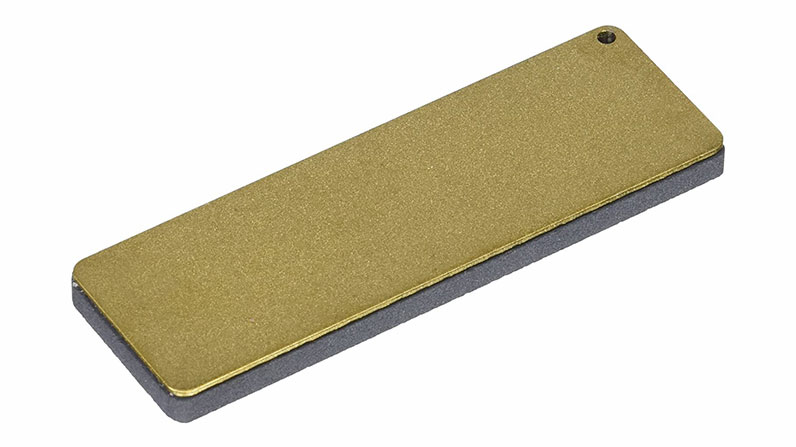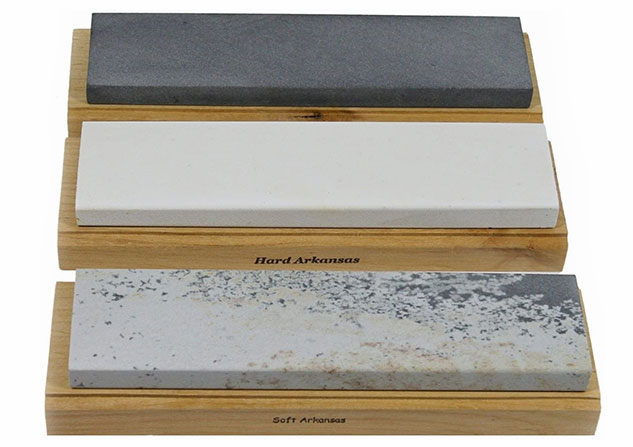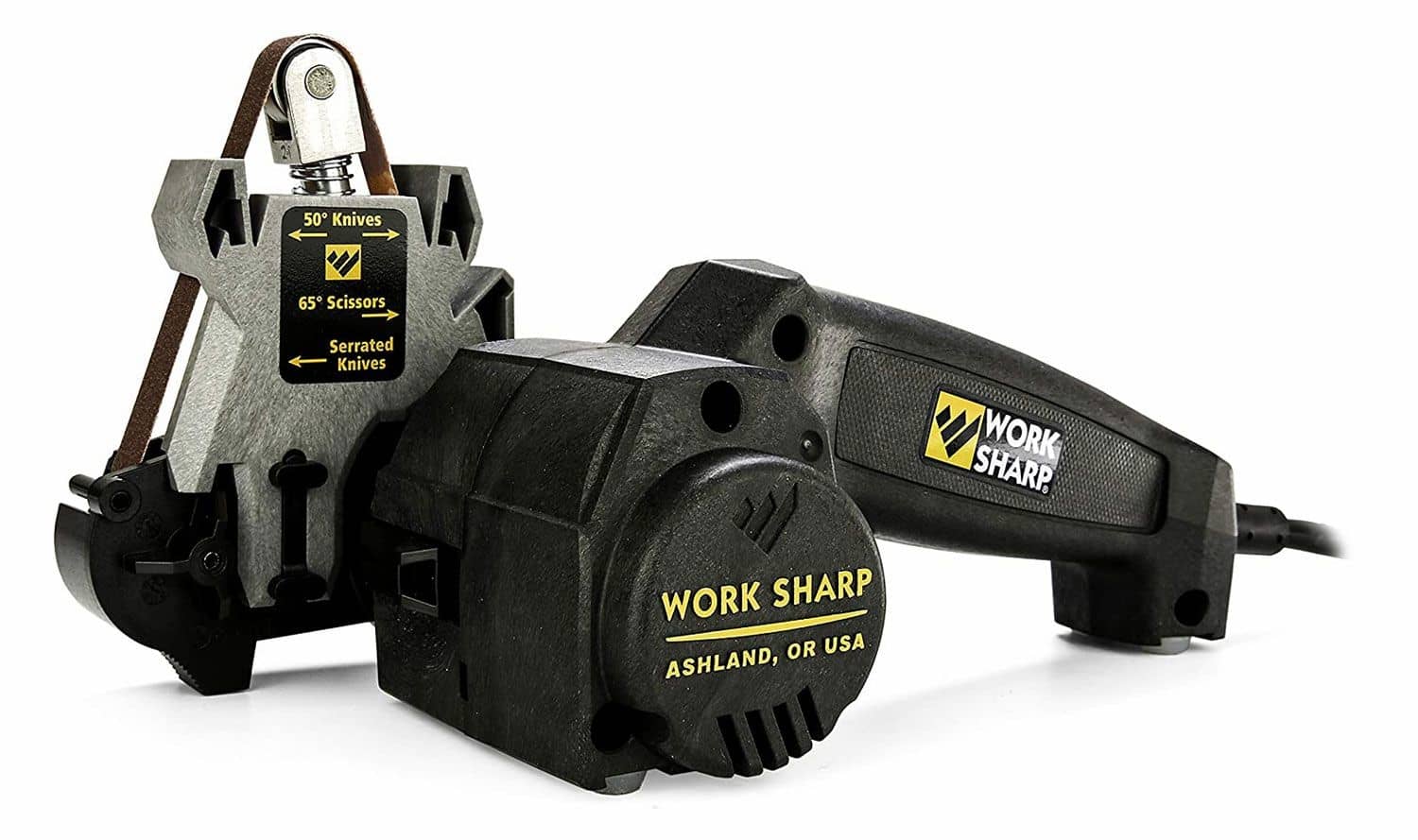One of the most vital tools for wilderness survival is the axe. It is essential for constructing shelters, making traps, and a wide variety of other woodworking projects that can often be a life or death matter when it comes to life in the wild. Knowing the significance that an axe has for life in the wild means that having a quality axe sharpener is equally as valuable. Using a dull axe means you’ll be spending a considerably longer amount of time doing the same tasks that could be quickly executed with a sharp axe. Having a good axe sharpener gives you the ability to prepare it for your next trip, or to take it into the field with you and put a new edge on your axe as needed. Let’s take a closer look at some of the best axe sharpeners and the different methods used to whet an axe blade.
“Give me six hours to chop down a tree and I will spend the first four sharpening the axe.”—Abraham Lincoln
Quick Navigation
How to Sharpen an Axe with a Stone
How to Sharpen an Axe with a File
Sharpening an Axe with a Belt Sander Sharpening an Axe with an Bench Grinder
| Product Name | Price | Rating | Type |
|---|---|---|---|
| Cell | $15.51 | sharpening stone | |
 | $19.89 | sharpening stone | |
Arkansas Sharpening Stone Set – Wood Mounted | $49.95 | sharpening stone | |
| Stanley 21-106 8-Inch Mill Bastard File | $$$$ | sharpening file | |
| Cell | $8.29 | sharpening file | |
| Helko Werk Dual Sided Axe Sharpening File | $23.00 | sharpening file | |
Dremel 3000-2/28 Variable Speed Rotary Tool Kit- 1 | $$$$ | electric sharpener | |
| Work Sharp Knife & Tool Sharpener | $97.71 | electric sharpener | |
| Grizzly Industrial G0865 – 8″ Bench Grinder with LED Lights | $111.95 | electric sharpener |
Why a dull axe is often more dangerous than a sharp one
I learned just how dangerous a dull axe can be years ago while on a camping trip with a few friends. As we prepared camp, Jeremy—who was not quite as adept in the outdoors as my brothers and I—produced an old, dull axe from his camping gear and prepared to cut some fallen logs for firewood. I cautioned him not to use the axe, which was so old that it was probably better suited to be a decorative item than an actual woodcutting tool. He protested, assuring me that he could safely wield the axe and shorten the fallen logs into usable lengths for our campfire. I cringed as I watched him swing the first few blows, noticing how quickly he realized that he’d have to apply a bit more force to get a proper cut since the axe was especially dull. Thinking of the other tasks at hand, I turned away slightly. My stomach dropped as I heard the telltale sound of the dull blade glancing off the log and making direct contact with Jeremy’s leg, just above the ankle. “It’s just a flesh wound,” he said, trying to maintain his sense of humor despite having hacked his leg open. We had quite a journey getting Jeremy to the nearest hospital, first traveling by boat and then via pickup truck along the winding back roads which took us into town. Through the whole ordeal, I developed a healthy new respect for sharpening axes. Several stitches later, Jeremy (and the rest of our group) had also gained a thorough understanding of the dangers a dull axe can pose, and the importance of having a sharp blade. And in order to make sure your axe stays sharp, here are a few different types of sharpeners you’ll want to consider.
Axe Sharpening Stones
Axe sharpening stones, also known as whetstones, are perhaps the most popular method of sharpening an axe. This is partly because they are simple to use, but also because a sharpening stone doesn’t take up much room and can be easily packed in with a load of other gear. One of the main drawbacks with axe sharpening stones is that they require specific knowledge of the exact kind of grain you’ll need, and some stones must be used with honing oil instead of water or dry sharpening. It’s important to understand as much as you can about the right way to use a particular type of sharpening stone. Sharpening stones can be naturally occurring rock, or manufactured whetstones that are specially designed for sharpening. Whetstones typically take longer to sharpen an axe, but they are relatively inexpensive and widely available.
1) Lansky Puck
The Lansky Puck is one of the most popular “puck” style sharpening stones that is currently available on the market. This pocket-sized, easy-to-pack sharpener is ideal for taking into the field for sharpening everything from knives, machetes, axes, and more. The Lansky Puck has two different grits, one coarse grain grit for sharpening dull blades and working out nicks in your axe, and one medium grain side for touching up blades that are already somewhat sharpened. The puck has an easy-to-grip, rounded design that makes sharpening an axe both easy and safe.
Pros
- Easy to use
- Small and lightweight
- Dual grain for both very dull blades, and dressing edges
Cons
- Does not come with pouch or honing oil
- Not ideal for small blades
2) Fallkniven Diamond-Ceramic Whetstone Sharpener
This compact diamond sharpening stone is likely the best value for anyone who really wants a dry sharpening stone that can be easily packed into their gear bag. It’s capable of sharpening any blade wet or dry. It’s dual grain with one side being a 600-grit for larger, more dull blades and a 1,200-grit side for finer projects that include dressing an already-sharpened knife, axe, or just about any other bladed tool. The diamond sharpening stone features finer grits than most other sharpening stones and will result in a sharper edge than just about anything else you’ll find. The Fallkniven Diamond sharpening stone is a bit smaller than most other stones, making it less-than-ideal for using to sharpening larger axes.
However, the fact that you can tote this item into the wilderness without the need for other sharpening components make this a quality go-to time for wilderness survival experts and just about anyone who utilizes bladed tools.
Pros
- Small and lightweight
- Does not require water or honing oil
- Leaves better edge than most other sharpening stones
Cons
- Stone can easily break under pressure due to flat design
3) Arkansas Sharpening Stone Set – Wood Mounted
This wood-mounted sharpening stone set is arguably one of the best you’ll find online. While it is a bit more expensive than most other sharpening stone sets, these stones will give you more control over your blade by offering more options for sharpening. The set comes with a 600, 1200, and 2000 grit stone that are all mounted to wooden platforms that can be secured to a desk, wooden plank, or anything else you prefer to place them on. The set is made of genuine Arkansas sharpening stones and is of the highest quality whetstones available.
Safety is always important when sharpening and each stone comes with an adhesive rubber footing to ensure that they won’t slip or slip while you’re using them. They can be ordered in three different lengths, 6”, 8” and 10” stones to allow you with the right amount of sharpening surface for your blade.
It should be noted that you can use both water and oil with these stones, but honing oil is generally considered best for high-grade sharpening stones like these. Once you do use honing oil on the stones, you’ll want to continue using only oil when sharpening as mixing oil and water on the whetstones will result in an ineffective surface for sharpening. These stones are American-made and come with a Lifetime Guarantee, making them an easy addition to our list of the best sharpening stones on the market in 2020.
Pros
- Available in variable lengths
- Three different grit options
- Made in USA
- Lifetime Warranty
- Can be used with oil or water
Cons
- Stones can crack if not handled carefully
How to Sharpen an Axe with a Stone
Most outdoorsmen prefer to use a sharpening stone to hone in the blade on their axe. Whether that’s based on the desire to use a traditional method, or the fact that sharpening stones are relatively inexpensive and easy to use remains to be seen. First, you’ll want to make an assessment of your axe blade’s condition to determine whether you’ll need to use a very coarse grit, or a more fine grit. If your axe has nicks or broken places in the blade, you’ll want to start with a low-grit rated sharpening stone first to work those out. If your axe is in very poor, dull condition, you’ll want to go with a higher grit rating. Be sure to apply any necessary honing oil or water to your axe before you begin sharpening. It’s crucial that you secure your axe in a fixed position before you start. Some users prefer to place them in a vice, but if you don’t have one of those, you can simply lay your axe on a flat surface, or place it in your lap. It’s also a smart idea to wear gloves to get a better grip and protect your hands from sustaining any severe cuts during the sharpening process. Pay attention to the axe’s belt, or angle at which the blade portion is set against the main body of the axe. Below is an outstanding video from Shrade Knives on the proper technique for using a stone to sharpen an axe.
The key is to be consistent with the motion that you use for sharpening your axe. Remember, you don’t need your axe to be razor sharp, so there’s usually no need to hone the edge more than what is needed for usual woodcutting tasks. One advantage you’ll have using a file as opposed to a sharpening stone is that files do not require the use of water or honing oil, which means you’ll have much less clean-up after you’re done.
Axe Sharpening Files
An axe sharpening file is generally used to hone or sharpen axes that are in disrepair and are overly dull or rusted. Most experienced woodworkers will start with a file and sharpen the edge down to a desirable degree, then they will use a sharpening stone to hone the axe blade in just a bit more. However, if you choose to use only a file, or you’re forced to use it because you have no other tools, you can rest assured that you’ll be able to get your axe very sharp using only a file. Most files are models after a “mill bastard file” which is an elongated, flat and narrow rod that can be used to file down just about anything. Files are usually a top choice for expert woodsmen and anyone who has a considerable time in the outdoors or working with wood. This is because a file can serve a multitude of different roles like sharpening knives, hooks, or just about anything else, which makes them highly efficient in the field. One of the only downsides to using a file is that you will likely produce a “burr” on the edge of your axe blade. A burr is created when you heavily work one side of the axe blade, causing the excess metal to slightly hang over the actual portion of the blade that you’re trying to work. We’ll get into that more later. A file is a great tool, easy to pack, and is ideal for quickly and easily sharpening your axe.
4) Stanley 21-106 8-Inch Mill Bastard File
Stanley is one of the most popular tool makers in the world and their 21-106 8-Inch Mill Bastard File is adequate for sharpening an axe blade without much fuss. This is a flat file that is made with a tapered length and width to allow you to get just the right angle when sharpening your axe. The file comes with standard bastard teeth spacing and single-cut mill pattern for light removal of material from your blade. One of the most appealing features of this file is that it offers a slip-resistant handle that also helps to eliminate vibration during use. This is a well-made file that will do the job with most axes. It’s also compact and can be easily packed in with a load of gear and not take up too much space. One of the only drawbacks to this file is that it’s case-hardened, which means they might not withstand use with extreme heat, but that shouldn’t ever be an issue if you intend to only use it to sharpen axes.
Pros
- Tapered length and thickness
- Ideal for honing and touching up blades
- Slip-resistant handle helps you maintain a consistent angle
Cons
- Case hardened (may not be as strong as other files)
5) Crescent Nicholson 8″ Rectangular Double/Single Cut Axe File
If you’re familiar with well-made files, you’ve likely heard of Nicholson. They’ve been around since 1864 and have been producing some of the finest sharpening files in the world ever since. This file features what’s known as an American file pattern which has a double-cut side for rough filing very dull blades, and a single-cut side for finishing and honing your axe. The Nicholson file is capable of sharpening just about anything from gardening tools to axes, but the long, rectangular shape makes this file ideal for using to sharpen axes as it gives the user more surface area. The file also has a widened handle to allow for better gripping. One of the only downsides to this product is that the handle is not widened like some other popular axe sharpening files and can sometimes be difficult to hold with a firm grip.
Pros
- Dual-sided
- Rectangular shape
- American pattern
- Widened handle
Cons
- Flat handle may be harder to grip
6) Helko Werk Dual Sided Axe Sharpening File
It has been said that there’s nothing quite like German steel. The Helko Werk Dual Sided file is everything you need in an axe sharpening file that will last a lifetime. Unlike most other files on the market, this one is designed specifically for axe sharpening. The stronger steel teeth mean you’ll be able to bring your axe to a mid-level sharpness faster than you would using other, weaker steel. While it’s not usually necessary to have your axe as sharp as a Japanese kitchen knife, you could get fairly close to that level of sharpness using this file and Helko’s sharpening stone in conjunction. One side of the file is a single-cut fine tooth pattern and the other side is a double-cut pattern. The double-cut is for no-nonsense sharpening and working a dull blade back into shape in short order. The single-cut is then used to hone in the edge you’ve made to the desired sharpness.
The file features a thick, flat handle that is great for getting a firm grip on and it also has a single hole on the end in case you want to place the file on a peg in your shop for quick and easy access.
Pros
- Crafted from German C125W2 high carbon tool steel
- Longer length
- Lightweight
- American pattern teeth
Cons
- Does not offer a large, rounded handle
- More expensive than most files
How to Sharpen an Axe with a File
Most skilled outdoorsmen and woodworkers will use a file to initially sharpen their blade before honing it’s edge with a sharpening stone. That doesn’t mean you can work your axe’s blade to medium-level sharpness using only a file. Pay attention to where your file is made because purchasing a cheaply-made file that was manufactured in China or Mexico means you’re likely getting low quality metal that will lose its teeth faster than other, more expensive brands. Before you start, you’ll want to clean your file of any debris using a wire brush. Most skilled craftsmen like to use a black marker to color the edge of their axe blade which will allow them to see when they’ve worn away the desired portion of the edge. The video below is a great example of the basic technique you’ll want to use for sharpening an axe with a file.
First, you’ll want to note whether your axe is made with a convex angle, or a scandi (flat) angle. You’ll need to keep that angle in order to achieve a fully-sharpened blade that will cut as desired in the field. As noted above, start with the double-cut side of your file if the axe is especially dull and worn. With each stroke, you’ll want to pull the file from the blade to the hilt and drag it at an angle so that you start near the tip of your file and finish at the bottom of your axe blade near the middle of your file. Once you’ve worked a decent edge, you can then switch to the single-cut side to hone in your blade to perfection. Be sure to follow the curve or angle of your axe blade and apply equal pressure with each stroke. If you’re working with a dull axe, you’ll want to slightly curve your file when you round the edge of your blade. This will finish out your axe edge and often will create a “burr” that we mentioned earlier. The burr is a small bit of metal that will overhang your edge when you work one side of the axe for an extended period of time. To get rid of this burr, simply flip the axe over and work the opposite side to an equal degree. You can always avoid creating this burr by filing a few strokes on one side, then flipping it over to make a few strokes on the opposite side and repeat. Keep working both sides of your axe until you have a desirable beltline, and it has reached the level of sharpness you want.
Electric Axe Sharpeners
As with just about any other area of outdoor-related tools, modern technological innovations have brought on newer and easier ways to sharpen your axe. While using power tools to sharpen your axe can make the job lightning-fast, there is also the greater chance for mistakes that will ruin your blade. If you choose to use electric axe sharpeners, be sure to pay close attention to every part of the process and don’t get in a hurry.
Dremel Tools
Dremel tools are great for quickly touching up or honing in axe blades. They are very effective and relatively easy to use. The only downside to using dremel tools is that they can easily damage an axe and make it very hard to repair broken portions of the blade. Most dremel tool enthusiasts prefer to use aluminum oxide which can strip away considerable amounts of metal to create a sharp edge on your axe very quickly. Be sure to keep some kind of water source nearby to dip your axe into because the metal can overheat and lose its temper, which will warp your blade. Using a dremel tool to sharpen an axe is straightforward, but be careful so as not to damage your blade. Simply run the dremel down the edge of the blade once on each side, assess the sharpness and continue until the blade has been sharpened to your liking.
Sharpening an Axe with a Belt Sander
Using a belt sander can be highly effective for getting a perfect angle on your axe, but it also comes with a high degree of risk. Users should be very cautious about employing belt grinding tools to sharpen their axes with. Be sure to wear eye protection and have the belt grinder set up in a way that will not result in injury. Belt grinders usually come with multiple grit rated belts that allow users to very quickly bring an old, dull axe back into working shape. It’s very important to follow the directions on your belt grinder as most brands come with specific instructions on how to properly use the product to sharpen an axe. When using a belt grinder, it’s very important to maintain a firm grip on your axe handle and to not apply too much pressure to your axe against the grinding belt as this will wear the metal down too much. As with other sharpening methods, you’ll want to use the very coarse belts for sharpening overly dull axes and the finer grit belts for touching up an already sharpened blade.
Sharpening an Axe with an Bench Grinder
Perhaps the easiest and fastest way to fully sharpen an axe is by using a bench grinder. These, like most other electric sharpening tools, can be highly dangerous when not used carefully. Make sure your bench grinder is firmly mounted to the surface you plan to use it on. Make sure to properly utilize any spark shields when sharpening your axe as you don’t want these getting near your face or clothing. Sharpening an axe using a bench grinder won’t take long at all, but it’s always a good idea to have water nearby to help cool the blade down so it won’t lose its temper. Be sure to pay attention to the curvature of the blade and carefully turn the axe as you sharpen it to maintain its rounded form.
7) Dremel 100-LG Lawn and Garden Rotary Tool Kit
This dremel tool is ideal for touching up your axe blade and anything else you might want to sharpen up without wasting too much time. A dremel isn’t the best electronic axe sharpener available, but it will do quite well to put a decent edge on just about any axe. This Dremel 100 set is perfect for sharpening axes in your shop and getting them ready to take into the field. It features three different sharpening attachments for use on a variety of different tools. It is capable of running up to 35,000 RPM, which makes sharpening your blade quick and easy.

Pros
- Easy to use
- Up to 35,000 RPM
- Comes with multiple attachments
Cons
- Does not include aluminum oxide grinding tool
8) Work Sharp Knife & Tool Sharpener
The Work Sharp Knife & Tool Sharpener is a very popular item for those looking to sharpen just about any kind of blade with very little effort. This tool comes with high-end abrasive belts that are not likely to cause damage to your axe or any other bladed tool when sharpening. This sharpener allows users to get the perfect 30 degree blade on any axe in a short amount of time. This belt grinder is capable of restoring an old, dull blade into working condition in a very short amount of time. While one of the only drawbacks is that you must follow the directions to the letter, this tool can come in quite handy for sharpening axes. Backed by a one-year warranty, the Work Sharp is a truly useful tool.
Pros
- One-year warranty
- Lightweight
- Easy to use
- Create the perfect edge on your axe
Cons
- Can take some getting used to
- Not ideal for larger axes
9) Grizzly Industrial G0865
The Grizzly Industrial bench grinder is just as capable as any other on the market at properly sharpening axes, but won’t cost you near as much as some of the more well-known power tool brands. With an 8” wheel size, the Grizzly is perfect for sharpening axes and getting the perfect edge in a short amount of time. This grinder is capable of 1,800 RPM and has a 1” width that will provide plenty of surface area on the wheel to work your axe across and sharpen. It also features spark shields, dust collection ports and lights that are built into each eye shield. This grinder offers much of the performance of most high-end grinders at a fraction of the price.
Pros
- 8” grinding wheel
- Adjustable eye shields
- Dust collection ports
- Built in lights
Cons
- Made with some cheaper components
What you should consider when choosing an axe sharpener

The Right Tool
Be sure to first determine the purpose of the axe sharpener you need. Is it something you’ll need to take with you into the field? Will you only use it a handful of times each year? Are you a hardcore outdoorsman who finds the need to regularly sharpen your axe? Make sure you select the right tool for your needs.

Quality
Like the saying goes, “You get what you pay for.” When searching for an axe sharpener, it’s often best to overlook some of the cheaper options available to you. Sometimes, a less expensive option is fine if you just need something that you might pack in with you on an outdoor trip, but be sure that you’re spending your money wisely on quality products that will last.

The Right Grit
It’s important to understand the differences in grits and how they are used in relation to axe sharpening. Here’s an easy-to-follow guide:
- 1000 and under grit – very coarse and used for sharpening damaged blades
- 1000-3000 grit – used to sharpen very dull edges into working order
- 4000-8000 – used for finishing and refining blades to a razor sharp edge

Best Value
It’s a good idea to seek out axe sharpening tools that can serve a dual purpose such as two-sided sharpening stones. Some of the best axe sharpening tools can be used to sharpen axes, as well as any other bladed tool you might have.

Bigger is Better
Unless you’re planning to sharpen a small hatchet, it’s often best to get the largest tool you can find to give yourself plenty of surface area to work with. Most large sharpening tools are capable of sharpening smaller axes, as well as large axes.

Safety is Key
Always investigate the safety features and protocols of any product you are thinking about purchasing. Sharpening an axe can be a dangerous endeavor that can lead to serious injury when you don’t follow common safety precautions. It’s often best to pay a little more for better safety features.
Conclusion
Now that you’ve read and understood the many different facets to axe sharpening tools, you can use this information to purchase the tools that are right for you. Be sure to look into all the details related to the product you plan to purchase and determine if other items are needed such as honing oils, etc. It’s recommended that you start out with the simplest form of axe sharpening tools like the whetstones which will allow you to attain a firm grasp of just how to sharpen an axe and get the right angle on a blade. From there, you’ll be able to increase your knowledge and determine whether or not you’ll really need an expensive tool like a bench grinder. We hope these tips help you keep your axe sharp and wits sharper!

Carlo’s introduction to the wilderness was during his stint in geothermal and geological surveying, which brought him to remote and unusual hiking spots all over Southeast Asia. His outdoor experience has made him an expert in axes and other types of saws.

